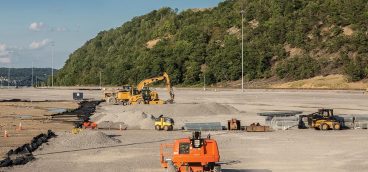
It was mid-afternoon in late winter, and the public relations man for one of the larger drilling companies in Pennsylvania was driving me back along a rutted country road from a rig we had just visited.
He had been extolling the virtues of the state’s vast cache of natural gas, ticking off the ways in which the Marcellus Shale soon would transform Pennsylvania’s economy and, at the same time, do good for the environment, when he stopped mid-sentence.
He was white-knuckling the wheel of his company-issued Ford SUV and looking at the needle on the fuel gauge.
“I’m not sure we’re gonna have enough gas to get back,” he muttered. Here we were, still within earshot of a drilling rig boring down into one of the richest deposits of fossil fuel in the world, a well that would soon produce millions of cubic feet of a clean-burning, low-emissions fuel. Yet we were in danger of having to hitchhike miles to a service station because neither the technology nor the infrastructure was available to actually use the resource that lay in such abundance beneath our feet. We made it to a gas station, but what had happened was a metaphor for the entire state.
Right now, three-quarters of Pennsylvania is sitting atop the Marcellus Shale, believed to be the third-largest natural gas field in the world, a 500-trillion-cubic-foot resource that could, if properly harnessed, not only be used to heat our homes for a generation or more, but also power more of our electrical generating plants, fuel our school buses and other fleet vehicles and even fuel some of our private cars and trucks. Since much of the hydrogen we use in this country is extracted from fossil fuels like natural gas, it could lay the groundwork for the next generation of cleaner-burning hydrogen vehicles, economists say. And since most of the nitrogen we use comes from the same source, natural gas from the Marcellus could also be used to manufacture, distribute and apply fertilizers to grow both food and the feed stocks for biofuels. What’s more, the readily available gas could lure more businesses and industries to the state, not just those that would use it to heat and power their factories, but those who use the elements of it as a raw material for manufacturing chemicals and plastics.
There have been halting steps toward unleashing all that potential. And yet, economists say that nearly six years after the first Marcellus well was drilled, neither the state, the gas industry, nor the environmental community and the larger business community have even begun to develop a comprehensive plan to really use the resources of the Marcellus.
For all the talk about how the rapidly expanding development of the Marcellus would be a “game changer” for the state and the region’s economy, so far, the economic impacts have been largely confined to the gas industry itself and to those few landowners from whose property the gas is being extracted. It’s a model that’s been replicated in gas fields and coal patches the world over, says Professor Tim Kelsey, an agricultural economist at Penn State who has studied the economic impacts of the Marcellus. “We’re extracting the resource, we’re getting paid for collecting the resource, but we’re shipping it off elsewhere, to other states, other places.”
There are certainly economic benefits to that kind of activity, says Dr. Ray Perryman, a Texas economist who has made a career out of studying the long-term economic impacts of the gas and oil industry. “In addition to the obvious gains from drilling activity and royalty payments, many related service industries will likely emerge, as well as engineering firm expansions, office leases and construction by major industry players and other direct activity. The extra income from royalties and relatively high-paying jobs also will support more retail spending and development, a stronger housing market, and other ‘multiplier’ effects. You also will likely see a spurt in local government revenues to support education and other public services.”
But there’s a danger in that basic drill-it-and-pump-it model, Perryman says. “While the long-term gains will likely be significant, activity will be cyclical. Periods of very active drilling will be interrupted by relatively slow periods,” when the price of natural gas drops as it does from time to time to a level where it makes more financial sense for a driller to lay down his rigs and wait for a price hike. “People who have lived around oil and gas for years are quite accustomed to these cycles, but it is sometimes a shock to neophytes. As an example, local governments should not base future planning on these revenues being available every year.”
What’s more, that model fails to expand the benefits of the Marcellus beyond those immediately involved in its development. In order to achieve a greater economic benefit, Pennsylvania, particularly the western part of the state, would need to become not just a producer of natural gas, but a consumer of it. In order to do that, however, Pennsylvania needs a plan, a thorough evaluation of the potential markets for natural gas, a clear-eyed examination of the risks involved in extracting it, a comprehensive policy to minimize the risks associated with that extraction and a plan to identify and target the kind of businesses that could be lured here or kept here by ready availability of natural gas. Pennsylvania, of course, does not exist in a vacuum, and federal action could have a significant impact on the future of a gas economy here. If, for example, the federal government decides to levy a tax on carbon emissions, that could drive some industries and utilities away from coal and toward natural gas. But even if that were to happen, the state would still need to develop its own master plan, and according to economists, politicians, community development officials and gas industry representatives, that kind of long-term vision has been in very short supply in Pennsylvania.
The truth is, there is already a sizable market for natural gas in the state. Like most of the nation, Pennsylvania consumes a significant quantity of natural gas as a heating fuel, primarily in the urban and suburban areas. But that, say industry experts, is only a fraction of the market that could be developed. There are vast swaths of the state, many of them right in the middle of the burgeoning gas fields and many more within a few miles of the major natural gas pipelines that cross the state, where there is no infrastructure to deliver natural gas heat to homes and no plan to develop that infrastructure.
The story is much the same when it comes to transportation. While the state has offered grants and incentives to government agencies and school districts to encourage the use of alternative fuels, there has never been a comprehensive plan to develop natural gas as a transportation fuel. Though it has been touted as a cleaner-burning alternative to diesel for fleet vehicles, there are only a handful of transit agencies in Pennsylvania that have even experimented with natural gas, the most successful to date being the Centre Area Transportation Authority, which runs its fleet of buses servicing State College and its environs exclusively on natural gas. In fact, the natural gas industry itself still relies almost entirely on diesel to run its rigs and operate the thousands of trucks it uses to extract the bridge fuel to the future from the ground. And when it comes to use as a fuel for passenger vehicles, Pennsylvania remains far behind other states, notably Utah, which has the largest number of privately operated vehicles running on liquefied natural gas. Currently, in Pennsylvania, there are about 26 service stations that can pump liquefied natural gas, and almost all of them are clustered around Pittsburgh and Philadelphia.
It is doubtful that liquid natural gas, or any other variant of it, will ever be more than a boutique fuel for private vehicles. Few manufacturers offer cars or trucks that can burn it, and retrofitting existing vehicles to run on liquid natural gas can be costly and time-consuming. What’s more, it would cost billions of dollars, analysts estimate, to build the infrastructure necessary to sell LNG next to the premium and regular at your neighborhood service station. But the state and the industry could do more to promote the use of natural gas as a fuel by actively encouraging more fleets of buses and trucks to use it. And if the state and industry were to promote the infrastructure to support those fleets, that could, with proper planning, form the matrix of an expanding network of natural gas-fueling facilities.
Nor has natural gas, often pitched as a cleaner alternative to coal and a safer choice than nuclear, made much headway as a fuel for electrical generation in Pennsylvania. According to state officials, more than half of the state’s electricity is created from burning coal, more than a third from nuclear plants, with the remaining 12 percent coming from all other sources, including wind, solar and natural gas. Once again, analysts say, little attention has thus far been paid to developing a plan to expand the use of natural gas in that industry.
And when it comes to using the state’s abundant natural gas as both an energy source and a raw material to drive the engines of commerce beyond the drilling industry itself — using it to lure industries that use the gas and its by-products as a material from which to make everything from nitrogen-based fertilizers and chemicals to plastics—there too, much more could be done.
That is not to say that there has been no progress in expanding the potential economic impact of the Marcellus. In the steel industry, for example, the development of the Marcellus has offered an immediate opportunity—one seized by TMK IPSCO-Steel which earlier this year began gearing up in Ohio to provide specialized steel pipes and fittings designed specifically for Marcellus gas drilling. But with proper planning and incentives, the state’s vast supplies of gas could have a far greater economic impact. Properly used, it could, for example, fire the blast furnaces needed to make that steel in the first place, a process that now, because of market economics, is largely done with coal, says TMK-IPSCO Chairman Piotr Galitzine.
In fact, the steel industry could convert tomorrow, says Doug Matthews, the president of U.S. Steel’s tubular division. “Based on what the commodity prices are, we can switch between coal and natural gas or liquid fuels to get the best economics over a period of cycle.” The Marcellus Shale has already removed one obstacle to switching those plants over to gas—there is now no fear that natural gas will become scarce anytime soon. But the cost of the fuel still remains an issue—gas is still more expensive than coal. There too, state and federal incentives to use natural gas, or a carbon tax on coal could tip the balance in favor of gas, he said.
The Allegheny Conference on Community Development is another organization that has recognized the far-reaching potential of the Marcellus. It has been working aggressively for the past few years to use the promise of ready fuel and reliable raw material from the Marcellus to lure new businesses to the region. “We had 44 projects in the region last year that were energy-related, and I believe 26 of them were in the natural gas field, including a number of folks who moved in from out of town,” said Dennis Yablonsky, the conference’s chief executive officer. “We’re trying to educate people in the region who aren’t involved in natural gas drilling but have the capability to be involved that they should be looking at this as a potential growth market, to produce, keep and retain local jobs.”
And there are other examples where individual businesses and industries have taken steps to take advantage of the economic benefits the Marcellus offers.
Across the state, the railroad industry has been quick to pick up on the potential. It has been actively touting itself as both a cost-effective and comparatively green way for those involved in the gas industry to move equipment to and waste from the far-flung corners of the state where gas drilling is under way. It is, says Joseph Geddes III of the Keystone Railroad Association, a boon to the state’s small- and medium-size freight lines, and it is also a more environmentally correct way of handling the freight. The rail industry claims that its diesel-electric locomotives can carry a ton of freight 457 miles on a single gallon of fuel, thus reducing not only the carbon footprint of Marcellus-related shipping, but also the wear and tear on the state’s highways and secondary roads, and the risk of dangerous and potentially toxic spills.
There have been other developments as well, including one that could serve as a perfect model for the kind of economic development that Yablonsky is trying to attract to Allegheny Co. In Wyoming Co., in the gas-rich northeastern part of the state, Procter & Gamble has recently begun work with Citrus Energy of Colorado to exploit the natural gas that lies beneath its sprawling 1,400-acre holdings along the Susquehanna River in Mehoopany. The plant, a paper-making facility, had for decades consumed more than 10 billion cubic feet a year of natural gas to fuel the massive machines that subject pulp and water to extreme heat in order to create paper. All of that gas had to be shipped 1,500 miles via pipeline from the Gulf of Mexico. Now, however, with just a few of what are expected to be several wells drilled, the company is already producing a sizable percentage of the gas it uses on-site. Citing confidentiality agreements with Citrus, P&G officials declined to say how much gas they’re currently extracting. But the company maintains that it eventually expects to provide enough gas on-site to meets its demands, and it may have enough left over to ship some of it back out of the pipeline that used to be used exclusively for bringing in out-of-state gas.
P&G spokesman Alex Fried says it was almost a no-brainer for both Procter & Gamble and Citrus. The paper plant got a reliable and cheap stream of energy, the driller got a regular customer in an industrial zone who could consume as much gas as the company could produce, and whatever was left over could be shipped to other consumers via existing infrastructure. It is, says Fried, a model that could be replicated elsewhere in the state. “The key things are either an existing industry that uses a lot of energy or a new one that would want to come in that wants access to gas and, as I think we all know, Pennsylvania is slowly turning into the Niagara Falls of gas. And then if you have property, or if a gas producer has nearby property that can also take on maybe a new industrial site, there are advantages for both parties.”
But projects like the Allegheny Conference’s economic development initiatives and P&G’s gamble on gas in Wyoming Co., are, for now, the exception rather than the rule. And part of the reason for that is that the economic development potential of the Marcellus Shale in Pennsylvania has been overshadowed, both for the Rendell administration and the gas industry itself, by the more immediate challenges posed by the rapidly developing drilling boom.
Thus far, the administration has focused its energies on beefing up its regulatory control and monitoring and responding to environmental missteps by drillers, ranging from taking action against Cabot Oil and Gas for a series of accidents in northeastern Pa.—among them one that resulted in 13 homes being subjected to methane contamination of their drinking water—to a spectacular blowout in June at a remote gas well in Clearfield Co. operated by EOG Resources. And the state has faced that challenge in the middle of a budget crisis.
It is perhaps a sign of where the administration’s focus has been that the point man for all things Marcellus in the governor’s office has been DEP Secretary John Hanger, a man with solid environmental credentials, but less experience in economic development.
Hanger certainly recognizes both the potential and the perils of the gas that is now being developed in the state. “We view gas as good fuel. It has a number of advantages. First, it is made in America, made in Pennsylvania. It is cleaner-burning than alternative fossil fuels, cleaner-burning than coal or oil. It can, in fact, reduce the air pollution that sickens people quite significantly,” Hanger told Pittsburgh Quarterly. “We can certainly run more of our power plants on gas than we ever have before. We can certainly run more of our vehicles on gas than we ever have before. At the end of the day, gas is in competition with other fuels. We do have in this state 46 power plants that are more than 40 years old, and the owners of those plants are going to have to make decisions about… how they’re going to power them, modernize them, and so, obviously, gas has an opportunity to play a part in those decisions.”
But ultimately, he said, it is not part of his portfolio to use the authority and the power of the state to develop a master plan, to levy and tailor taxes to create incentives to expand the state’s natural gas infrastructure and extend the range of uses for the resource. Unlike Colorado, which recently enacted a law requiring its largest utility companies to retrofit several existing coal-burning power plants to run on natural gas, Pennsylvania is largely taking a laissez-faire approach. If natural gas is going to play a bigger role in the state’s energy and economic future, Hanger says, it’s going to be largely up to the gas industry itself to make that happen.
“It’s not up to state government to sell the product. We’re glad to be helpful, we believe the gas industry has a good product and we have encouraged the gas industry to seek more markets for it, like transportation,” Hanger said. “We have provided grants to schools to run their school buses in gas, to some public transit systems to convert their buses to natural gas, and grants and loans to some waste companies to convert their waste trucks. But fundamentally, we believe that the natural gas industry needs to take the leadership in promoting natural gas, creating the fueling infrastructure that will be necessary for more vehicles to run on natural gas. We can play an assisting role, but the industry itself, is highly profitable, and it is in their interest to have their product used more, and they need to take the lead. We can partner with them but we’re going to be a junior partner, and they’re going to be the leading partner. “
In that, at least, the administration and the industry are more or less in accord. As Kathryn Klaber, president of the Marcellus Shale Coalition, the industry’s trade group, sees it, there is a role for limited government involvement. She cited the same grants Hanger mentioned to encourage the use of natural gas-fueled vehicles for fleet and public transportation. But Klaber maintains that it will be the market, and primarily the market, that drives the future economic direction of the Marcellus. And it will be the market that decides what the infrastructure needed to deliver and use it will be. “This infrastructure is being funded privately,” Klaber said. “I think we’ve got to get ourselves out of this mindset that seems to be gripping the country right now that if it’s not for the government—state, local and federal—then we can’t get stuff done.”
With the Rendell administration now in its final months and the industry under increasing scrutiny after a series of high- profile accidents, the days of “if you drill it they will come” economics may be nearing an end in the Marcellus.
Both Democratic gubernatorial candidate Dan Onorato and his GOP opponent, Attorney General Tom Corbett, have pledged to take a more robust approach to the economic development opportunities and challenges than the Rendell administration has.
“This is a great opportunity, but it’s only that, an opportunity. And we get one chance to get it right,” Onorato told Pittsburgh Quarterly. “I support the industry. I support coming up with a reasonable impact-severance tax that will actually fund environmental protection, would fund an impact fund which would give us money for infrastructure for roads, water lines and sewers for municipalities, and even possibly fund a growing greener tree fund…that would give us money to preserve open space and restore brownfields. So that’s one way it could benefit us.”
Beyond that, Onorato says, he envisions using tax policy and incentives to encourage other companies, both from inside and outside Pennsylvania, to replicate the kinds of initiatives that Procter & Gamble is taking in Wyoming Co.
“As governor, what I would like to do is, as the industry grows, as we start getting gas out of the ground… I would focus on (establishing) economic zones or development sites where we use the proximity of the gas to our advantage right on the site. We don’t have to transport it. It’s one of our competitive advantages in the state,” Onorato said. The way Onorato sees it, the state could be instrumental in helping to establish and aggressively market “several sites around the commonwealth for economic activity—everything from advanced manufacturing to commercial activities… wherever you could use natural gas. If the utility costs can be cheaper here, that goes to the factors of why you want to be in Pennsylvania.”
For his part, Corbett contends that the state, under his leadership, would take a more proactive role in identifying the opportunities offered by the Marcellus and then work more aggressively than the current administration has to meld the interests of the public and private sector. He advocates switching a large number of state vehicles to run on natural gas, with the idea that such a move would not only add to the demand for natural gas, but also encourage private fleets and more transit authorities to follow.
But beyond that, Corbett says he believes that the state should take the lead in developing a comprehensive energy plan that considers both the environmental and economic aspects, not just of the Marcellus, but also of the state’s coal reserves, and charts a way to go forward in developing them. And, he says, among his top five priorities as governor would be to establish a panel of experts from the public, private and academic sectors to begin work on that.
“We need to develop…an energy plan for Pennsylvania. The country doesn’t have one. With the resources that are available to us, it is incumbent upon us to come up with a master energy plan at least for Pennsylvania… That would also require… sitting down with businesses of all sizes, sitting down with local governments of all sizes because we need to encourage not only the state to begin using those natural resources, but also local and county governments,” he said.
Ultimately, however, neither the state, nor the industry, nor the environmental community alone can ensure that the benefits of the vast Marcellus gas reserves in Pennsylvania can be responsibly extracted and used for the greatest benefit. As Yablonsky of the Allegheny Conference put it, “No one group has the ultimate responsibility.” The state has to take a leadership role, so does the industry, and “the environmental community has a role in all of this.” But for the moment, that kind of combined leadership is a resource that is still waiting to be tapped.





